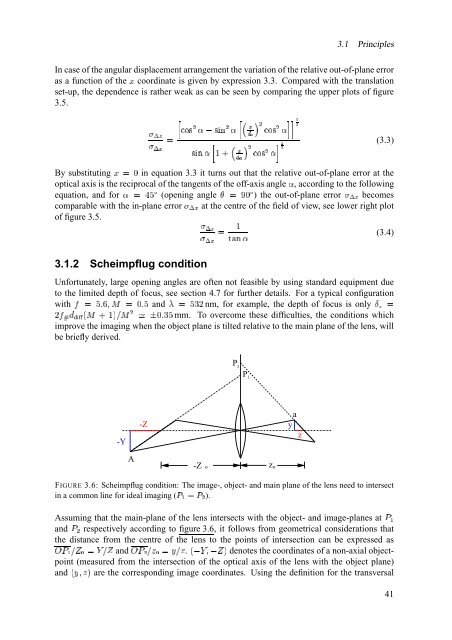The significance of coherent flow structures for the turbulent mixing ...
The significance of coherent flow structures for the turbulent mixing ...
The significance of coherent flow structures for the turbulent mixing ...
You also want an ePaper? Increase the reach of your titles
YUMPU automatically turns print PDFs into web optimized ePapers that Google loves.
Æ<br />
e¼c’„ïG<br />
ù<br />
#<br />
#dc’e<br />
›<br />
B<br />
›<br />
J<br />
ù<br />
ÿ©«ªa¬<br />
B<br />
›<br />
B<br />
›<br />
z<br />
<br />
J<br />
ù<br />
©<br />
&<br />
o<br />
º"»<br />
‘a#a¸<br />
<br />
¯<br />
3.1 Principles<br />
In case <strong>of</strong> <strong>the</strong> angular displacement arrangement <strong>the</strong> variation <strong>of</strong> <strong>the</strong> relative out-<strong>of</strong>-plane error<br />
as a function <strong>of</strong> <strong>the</strong> T coordinate is given by expression 3.3. Compared with <strong>the</strong> translation<br />
set-up, <strong>the</strong> dependence is ra<strong>the</strong>r weak as can be seen by comparing <strong>the</strong> upper plots <strong>of</strong> figure<br />
3.5.<br />
<br />
µ´«´ ·<br />
¬v® o<br />
°²±0³ J<br />
· (3.3)<br />
B œ<br />
¨v¯<br />
©«ªa¬<br />
° ± ³ J<br />
µ´¡<br />
By substituting in equation 3.3 it turns out that <strong>the</strong> relative out-<strong>of</strong>-plane error at <strong>the</strong><br />
optical axis is <strong>the</strong> reciprocal <strong>of</strong> <strong>the</strong> tangents <strong>of</strong> <strong>the</strong> T<br />
<strong>of</strong>f-axis angle , according to <strong>the</strong><br />
}<br />
following<br />
equation, and <strong>for</strong> B œ<br />
(opening angle ¹ e¸ ) <strong>the</strong> out-<strong>of</strong>-plane error › becomes<br />
comparable with <strong>the</strong> in-plane error J at <strong>the</strong> centre <strong>of</strong> <strong>the</strong> field <strong>of</strong> view, see lower right plot<br />
›<br />
<strong>of</strong> figure<br />
ù<br />
3.5.<br />
ù<br />
Bmœ<br />
(3.4)<br />
¬v® o<br />
¨ &<br />
©«ªa¬<br />
3.1.2 Scheimpflug condition<br />
Un<strong>for</strong>tunately, large opening angles are <strong>of</strong>ten not feasible by using standard equipment due<br />
to <strong>the</strong> limited depth <strong>of</strong> focus, see section 4.7 <strong>for</strong> fur<strong>the</strong>r details. For a typical configuration<br />
nm, <strong>for</strong> example, <strong>the</strong> depth <strong>of</strong> focus is only ¾<br />
ù<br />
with<br />
ù<br />
z fÀ¿ _<br />
f<br />
½<br />
© ÃÂ b<br />
and<br />
#]c’“•e mm. To overcome <strong>the</strong>se difficulties, <strong>the</strong> conditions which<br />
diffîG<br />
&óÁG<br />
improve <strong>the</strong> imaging when <strong>the</strong> object plane is tilted relative to <strong>the</strong> main plane <strong>of</strong> <strong>the</strong> lens, will<br />
be briefly derived.<br />
ù<br />
e“<br />
œ ù<br />
P<br />
2<br />
P<br />
1<br />
-Y<br />
A<br />
-Z<br />
a<br />
y<br />
z<br />
-Z o<br />
z o<br />
FIGURE 3.6: Scheimpflug condition: <strong>The</strong> image-, object- and main plane <strong>of</strong> <strong>the</strong> lens need to intersect<br />
in a common line <strong>for</strong> ideal imaging (Ä r +€Ä ).<br />
Assuming that <strong>the</strong> main-plane <strong>of</strong> <strong>the</strong> lens intersects with <strong>the</strong> object- and image-planes at Å r<br />
and Å respectively according to figure 3.6, it follows from geometrical considerations that<br />
<strong>the</strong> distance from <strong>the</strong> centre <strong>of</strong> <strong>the</strong> lens to <strong>the</strong> points <strong>of</strong> intersection can be expressed as<br />
Å r 0Ç ã<br />
ÁÇ ùÉÈ<br />
and Æ Å<br />
.îÊȤï0 Ç ódenotes <strong>the</strong> coordinates <strong>of</strong> a non-axial objectpoint<br />
(measured from <strong>the</strong> intersection <strong>of</strong> <strong>the</strong> optical axis <strong>of</strong> <strong>the</strong> lens with <strong>the</strong> object plane)<br />
<strong>the</strong> corresponding image coordinates. Using <strong>the</strong> definition <strong>for</strong> <strong>the</strong> transversal<br />
Eã ù§ñE<br />
andîñ\ïEó<br />
are<br />
41
















